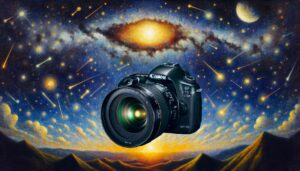This site contains affiliate links to products. I may receive a commission for purchases made through these links.
When you gaze up at the night sky, don’t you wish you could capture the beauty of the planets? I know I do. It’s a challenge that’s fascinated me for years.
Learning how to photograph planets isn’t just about pointing your camera at the sky and hoping for the best. It’s a blend of the right equipment, perfect timing, and a dash of patience.
Choosing the Right Equipment
Selecting the ideal gear is absolutely critical for planet capture. As we dive deep into this process, remember that every piece of equipment you use can influence your final image. From the camera body to the lens and even additional accessories, everything plays a pivotal role.
Cameras: If you’re serious about astrophotography, investing in a high-quality DSLR or mirrorless camera is mandatory. These models offer greater control over settings such as shutter speed, ISO, and aperture, which are all key to capturing sharp images in low light conditions.
Lenses: A telephoto lens with a long focal length is your best bet. The extra millimeters can go a long way in helping you get that detailed shot of Mars or Jupiter.
Telescopes: Consider investing in a telescope that has a ‘Go-To Mount.’ This technology automatically tracks the movement of celestial bodies, making it much easier to follow and photograph them.
Tripods: A sturdy tripod is also worth the investment. It’s crucial for long exposure times often required in this field and can prevent any undesirable movement.
In addition to the main equipment, don’t forget accessories. Extra necessities might include a remote shutter release to eliminate camera shake, additional batteries for long shooting sessions, a star tracker for precise celestial tracking, and lens heaters to prevent lens fogging.
That’s your basic astrophotography kit. But remember, excellent results are not entirely dependent on the equipment. Your knowledge and application of photographic techniques and your understanding of the celestial bodies hold similar weight in determining the quality of your shots.
Next up, we’ll be diving into timing, preparation, and technique for capturing those stunning extraterrestrial shots. Let’s proceed to get some eye-catching, heart-stopping, gallery-quality images of our solar system.
Understanding the Planetary Alignment
After we’ve discussed the importance of equipment in our previous section, let’s now delve into the crucial part of our photography journey—understanding the planetary alignment. Whether we’re aiming for Mars, Jupiter, or Saturn, knowing where to find them in the night sky is a prerequisite.
Planetary alignment is basically the positional relationship between planets in our solar system, as observed from Earth. These celestial bodies follow a predictable path across our night sky, a feature that makes planetary photography possible and exciting.
Now you may wonder, how can I track the celestial paths? Fret not. We live in an era where technology simplifies this task. There are numerous astronomy apps on the market Star Walk, SkySafari, and Stellarium among others, which can help locate planets, constellations, and other celestial objects in real-time. You just need to input your geographical coordinates and date, and voila!
Let’s consider some important factors regarding planetary alignment. Season is significant in obtaining clear images, with each planet having a peak viewing period during certain times of the year. For example, Mars is best viewed in late summer and early autumn, while Jupiter shines brightest during late spring and early summer.
Here’s a quick snapshot of optimal viewing times for visible planets:
| Planet | Best Viewing Time |
|---|---|
| Mercury | Early Spring and Late Autumn |
| Venus | Late Spring and Early Winter |
| Mars | Late Summer and Early Autumn |
| Jupiter | Late Spring and Early Summer |
| Saturn | Mid-Summer |
Understanding these elements will be paramount for your success. Remember, it’s not just about having the best equipment, it’s also about understanding and aligning with the rhythm of our celestial neighbors. Next, we will discuss the art of patience and the importance of weather conditions in astrophotography.
Finding the Perfect Location
We can’t stress enough the significance of location when it comes to planetary photography. Sure, you’ve got your gear and you know the whereabouts of the planets. But without an ideal location, you’re less likely to capture that breathtaking shot you’re aiming for.
Choosing the right location involves considering light pollution, atmospheric conditions, and horizon visibility. It’s tricky, but with the right knowledge, totally doable.
Let’s tackle each aspect to give you a clearer picture.
Dealing with Light Pollution
Light pollution is a common issue for every astrophotographer. It’s the blight of modern living; the ever-glowing halo of artificial lights. This unnecessary glow washes out starlight in the night sky, hindering the view of celestial objects.
Some might suggest simply heading out to the countryside, away from the city lights. And while that’s a good starting point, it’s not enough. We’ve got a solution: the Bortle Scale. This handy scale measures the night sky’s brightness. Lower numbers indicate darker skies. Ideal numbers fall between 1 and 3.
Literally going the extra mile to find areas that register as 1-3 on the scale can significantly boost your chances of capturing the planets. Location truly makes a difference here.
Understanding Atmospheric Conditions
Another variable in the equation is atmospheric conditions. Clear skies are the bread and butter of successful planetary photography. A cloudless, unpolluted sky ensures unobstructed views of the celestial bodies.
Additionally, stay aware of the atmospheric seeing conditions – meaning, the steadiness of the air. When it’s steady, stars don’t twinkle, and the view through a telescope becomes crystal clear. Sites with exceptional seeing conditions are associated with high elevations, consistent weather patterns, and proximity to large bodies of water.
Horizon Visibility
Last but not least, ensure unimpeded visibility towards the horizon. If a planet is near the horizon, buildings, trees or hills might block your view. Search for a spot that offers a wide, open vista. Good visibility ultimately leads to greater opportunities for capturing outstanding images.
Setting Up Your Camera
Once you’ve established the right location, spotting a planet against the dark canvas of the sky is only part of the challenge. The next major step is setting up your camera correctly.
The first thing to consider is the camera mode. For planetary photography, you’ll want to go full manual mode. This gives you full control over exposure settings like aperture, shutter speed, and ISO. Auto settings often won’t cut it, as the camera’s light meter can get confused by the darkness of the sky and overexpose the shot.
Next up, think about your lens selection. Planets are tiny, far-away subjects, so you’ll need serious magnification. A telephoto lens would be your best bet with at least 200mm focal length, the higher the better. To keep your image sharp, a tripod is a must. It’ll eliminate camera shake and allow for long exposures to capture all the planetary details.
Focus is absolutely critical. There’s nothing more frustrating than capturing the perfect shot only to find that it’s out of focus. To make sure you nail the sharpness every time, I recommend switching to manual focus and using the Live View mode on your camera. This allows you to zoom in on the screen, adjust the ring until the stars are as small and sharp as possible, then capturing the shot.
Lastly, in post-processing, RAW files will give you way more flexibility than JPEGs. They contain more details and allow a greater level of adjustment in editing software without leading to quality drain.
In the table below, you can find a quick summary of these camera settings:
| Camera Setting | Recommendation |
|---|---|
| Mode | Manual |
| Lens | Telephoto, >=200mm |
| Stabilization | Tripod |
| Focus | Manual, using Live View mode |
| File Format | RAW |
After nailing down these settings, let’s move on to other techniques you need to bring out the beauty of celestial bodies.
Mastering the Timing and Patience
When it comes to photographing the night sky, timing isn’t just everything—it’s the only thing. The key to capturing those luminescent shots of our celestial neighbors lies in the alignment of the planets, your location, and the weather conditions.
Firstly, the positioning of the planets is crucial. Our solar system is in constant flux, with planets moving and changing positions regularly. A knowledgeable astro-photographer knows when the planets will be in the most photogenic positions. Familiarize yourself with a star map or a reliable astronomy app to keep track.
Secondly, your geographic location can significantly impact your ability to photograph the planets. In places with less light pollution, planets appear brighter and clearer. So, when possible, escape the city and head to rural, dark-sky locations.
Thirdly, the weather conditions immensely impact your attempts to photograph planets. The ideal night would be clear and without clouds. Also, lower humidity leads to sharper planet images, so keep an eye on the weather forecast!
Seeing a great shot isn’t just about preparation, though—it’s about patience. Astro-photography requires waiting and observing. There might be many long and unfruitful nights before you capture that one perfect shot of Jupiter or Saturn. It’s a trial-and-error process which trains one’s patience. But when that perfect moment arrives, you’ll know all the waiting was worth it.
My years of experience have taught me that an understanding of planetary alignment, location selection, and weather conditions – combined with a good dose of patience – can make all the difference in capturing breathtaking images of our captivating solar system.
Astronomy alerts can help you track the best times for stargazing. Some popular options include:
- Sky Live
- SkySafari
- Stellarium
Conclusion
I’ve walked you through the ins and outs of photographing planets. Remember, it’s not just about the gear but also about understanding the celestial dance of the planets. Timing is everything in this game. Your location on Earth and the sky’s mood also play crucial roles in getting that perfect shot.
But above all, it’s your patience and keen observation that’ll make you a successful astrophotographer. So, gear up, keep an eye on the sky, and let the universe reveal its wonders to you. The beauty of the solar system awaits your lens!
Frequently Asked Questions
Why is the choice of equipment important in planetary photography?
Choosing the right equipment plays a significant role because each piece contributes to the quality and detail of the images. High-quality lenses and cameras equipped for night photography can critically enhance the final result.
What is planetary alignment and why is it essential?
Planetary alignment refers to the position of the planets in relation to each other and the sun. Understanding this is crucial as it impacts the visibility of the planets and determines the best time for photography.
How does geographic location impact planetary photography?
Photographic visibility of planets significantly varies depending on the viewer’s geographical location. Therefore, selecting a location with minimal light pollution and clear horizons is advised for best results.




